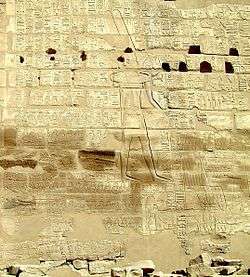Sack of Jerusalem (10th century BC)
| Sack of Jerusalem | |||
|---|---|---|---|
 The Bubastite Portal shows the god Amun-Re with names of Hebrew towns Shoshenq I, often identified with the biblical Shishak, claimed to have captured. Jerusalem does not occur in the list.[1]:174–175 | |||
| |||
| Belligerents | |||
| Kingdom of Judah | Egypt | ||
| Commanders and leaders | |||
| Rehoboam | Shishaq | ||
| Strength | |||
| Much fewer | Unknown | ||
| Casualties and losses | |||
| Unknown | Unknown | ||
The Sack of Jerusalem is an event described in the First Book of Kings of the Hebrew Bible and Christian Old Testament, and, with some differences, in the Second Book of Chronicles.
According to these sources it took place in the 5th year of the reign of Rehoboam,[2] following the death of his father,[3] Solomon. This event is thought to have occurred c.925 BCE[1][4][5] when the ancient Egyptian Pharaoh Shishak supposedly captured and pillaged Jerusalem. Possibly this was the same Pharaoh as the historical Shoshenq I who invaded Canaan following the Battle of Bitter Lakes.[6][7] Shishak (Hebrew: שישק) raided the Kingdom of Judah with his allies, including the Kushites, taking a number of hill towns[8] and sacking Jerusalem, all without fighting. Shishak took away treasures of the Temple of Yahweh and the king's house, as well as shields of gold which Solomon had made;[2] Rehoboam replaced them with brass ones.
Biblical narrative (1 Kings and Chronicles)
According to 2 Chronicles 12, Shishak, leading an army of 60,000 horsemen and 1,200 chariots,[7] invaded Judah and sacked Jerusalem in order to assist his ally, Jeroboam, the king of Israel. According to Josephus, his army met with no resistance throughout the campaign, taking Rehoboam's most fortified cities "without fighting." Finally, he conquered Jerusalem without resistance, because "Rehoboam was afraid." Shishak did not destroy Jerusalem, but forced King Rehoboam of Judah to strip the Temple and his treasury of their gold and movable treasures.[9]
The Bubastite Portal
The Bubastite Portal, a relief discovered at Karnak, in Upper Egypt, and similar reliefs on the walls of a small temple of Amun at el-Hibeh, shows Pharaoh Shoshenq I holding in his hand a bound group of prisoners. The names of captured towns are located primarily in the territory of the kingdom of Israel (including Megiddo), with a few listed in the Negeb, and perhaps Philistia. Some of these include a few of the towns that Rehoboam had fortified according to Chronicles[10]
The portal is generally believed to record a historical campaign of Sheshonq I in Judah, but it makes no mention of Jerusalem being sacked, nor of Rehoboam or Jeroboam. Various explanations of this omission of Jerusalem have been proposed: its name may have been erased, the list may have been copied from an older pharaoh's list of conquests, or Jeroboam's ransoming the city (as described in the Book of Chronicles) would have saved it from being listed.[4] According to Finkelstein, the ransoming account is highly unlikely given the paucity of the material culture of 10th century Judah, and regards it as a theological construction.[1]
References
- 1 2 3 Finkelstein, Israel (2006). "The Last Labayu: King Saul and the Expansion of the First North Israelite Territorial Entity". In Amit, Yairah; Ben Zvi, Ehud; Finkelstein, Israel; Lipschits, Oded. Essays on Ancient Israel in Its Near Eastern Context: A Tribute to Nadav Naʼaman. Eisenbrauns. pp. 171 ff. ISBN 9781575061283.
- 1 2 1 Kings 14:25; 2 Chronicles 12:1-12
- ↑ 1 Kings 11:40
- 1 2 'Did Pharaoh Sheshonq Attack Jerusalem?' - Biblical Archaeology Review - 1 July 2014
- ↑ 'The Chronological Study Bible', Thomas Nelson (2008) - Google Books pg 520
- ↑ http://www.archpark.org.il/
- 1 2 'The First Oppressors: Shishak of Egypt' - BiblicalStudies.org pg1
- ↑ 2 Chronicles 12:4
- ↑ Antiquities of the Jews - Book VIII, Chapter X.
- ↑ 2 Chronicles 11:5-12
External links
- The Campaign of Pharaoh Shoshenq I in Palestine, by Kevin A. Wilson
- The Palestine Campaign of Sheshonq I
- The Sack of Jerusalem on Templemount.org